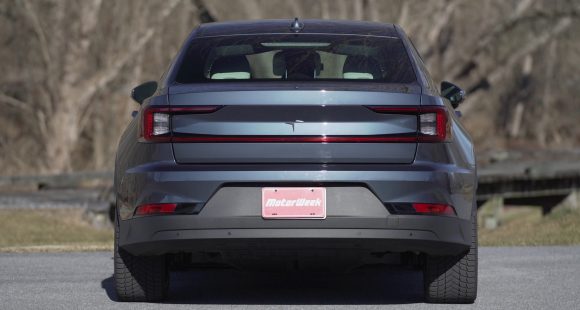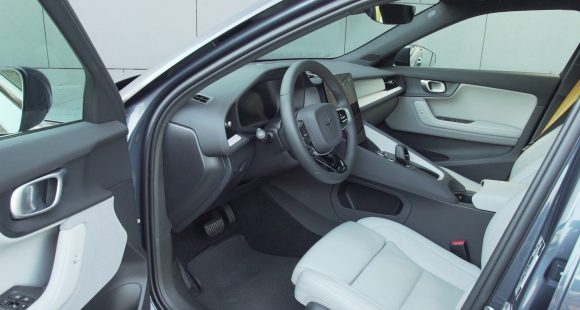2023 Porsche 911 GT3 RS
Level Up
At this point, we’ve given up predicting just how far Porsche can go with the iconic 911. For almost 60-years now, they’ve proved this rear-engine sports car is capable of things few thought possible. And now there’s a new GT3 RS that yet again takes performance to a new level. Time for us to try to figure it all out through the twists and turns of Savannah’s Roebling Road Raceway.
When it comes to driving this latest 992 generation of 911, each iteration that has arrived since 2019 has taken things to the next level, and granted driving rewards like never before. But like a video game or phone apps we waste countless hours on, just when you think you’ve reached the final level, there’s yet another quest to undertake. That brings us to this 2023 Porsche 911 GT3 RS.
It’s easily the most capable street-legal 911 yet, so tackling the 9-turns of Roebling is a challenge we couldn’t wait to take on. While it looks like a straight up race car; at its heart, it still feels like a 911. That basically means it’s way easier to drive than it should be, making you feel like a driving hero, despite your actual skills being far from it.
A big area of development for the RS was in aerodynamics; with active aero for the first time on a 911 GT3, enabling 3 times the amount of downforce of a standard GT3. Plus, a drag reduction system actively adjusting airflow up front and in back with an active multi-level wing.
Even front suspension parts have been reshaped, and front and rear wheel wells carefully chopped up to maximize airflow. That all means an immense amount of grip transferred to the 335 rear tires, which are mounted on your choice of forged aluminum, lightweight aluminum, or magnesium wheels. These sweet Indigo Blue 20-inch fronts and 21-inch rears are the aluminum lightweights.
It also means less drag down the long front straight, where we saw speeds well into the 160s at the end of it, while at the same time seeing corner speeds higher than we’ve ever experienced before here at Roebling. Getting on the throttle coming out of the turns is not a scary proposition at all, just immediate drama-free acceleration that has you wishing you would have gotten on the throttle harder and sooner.
And here in the RS, there are more possible tweaks than most of us know what to do with; typical suspension rebound and compression adjustments, but also rear differential settings, and you don’t even need to break out any tools, just turn the right dials on the steering wheel. That wheel is sensitive to even the most minor inputs, but not hyper feeling; just a willing and able point and shoot partner.
The RS still boasts the GT’s rear-mounted 4.0-liter flat-6, breathing free and unassisted by turbos, spinning up 518-horsepower and 342 lb-ft. of torque on its way to 9,000 rpm. Cooling is aided by a single large central front-mounted radiator instead of the standard GT3’s multi radiator approach. Added roof fins aren’t there for downforce, but for diverting hot air away from air intakes.
Rear-wheel-drive and PDK only, which makes launching as simple as it can be, repeatable, stress free, no-brain launches are hard with a fair amount of weight transfer, catapulting us to 60 in a scant 2.9-seconds. Shifts are quick and brutal, wasting no time or effort helping us complete the ¼-mile in 11.0-seconds flat at 128 miles-per-hour. And if that doesn’t put a smile on your face, you’re probably not doing it right.
The PDK transmission seems to know the exact right gear to be in at all times, but if you do trigger them, you’ll find the paddle shifters don’t quite feel as purposeful as the rest of the car, though the pro car’s magnesium units are available in the optional Weissach Package.
Things inside the RS look as serious as the outside; there’s a GT shifter, lots of chassis bracing, and unique well-bolstered full bucket seats. And while it mostly feels like a race car, all the modern tech you need to get you through your daily business is on hand, works well, and looks great.
Doors, hood, front fenders, and roof are all made of Carbon-Fiber Reinforced Plastic. And one final touch we’re fans of, the exterior graphics are a throwback to 1972’s 911 Carrera RS 2.7.
RS pricing starts steep at $225,250, about $50,000 over a standard GT3.
So, what is it that makes the 2023 Porsche 911 GT3 RS so special? Yes, it’s packed full of unique tech and race-spec. goodies that enable an amazing amount of performance to make it a weapon of mass domination for pro drivers. But, really, it’s the accessibility of all that performance that turns the RS into a hero-maker for the rest of us. That makes it really special indeed.
Specifications
- Engine: 4.0L Flat-6
- Horsepower: 518
- Torque: 342 lb-ft
- 0-60 mph: 2.9 seconds
- 1/4 Mile: 11.0 seconds at 128 mph
2024 Polestar 2
More Range And More Power For The Polestar 2
Volvo is well on their way to making the transition to an all-electric brand, but their sister-brand Polestar is already there. Now, we’ve spent lots of time in their all-wheel drive, five-door Polestar 2, having tested it in 2021, and a year later when a two-wheel drive version arrived. But, EV updates are coming quickly. So, let us be your guide for all that’s new with the Polestar 2.
While we are driving more EVs than ever, we’ve also been spending a lot of time recently circling back to ones we’ve previously tested. As in this new era of electrified vehicles, significant updates are arriving quickly, with R&D investments increasing and retrofitting them easier than ever. This is often done through software updates that can even be accomplished over the air. For 2024, the Polestar 2 has indeed gotten some software updates, but some physical ones as well.
Clearly aimed directly at Tesla’s Model 3 when it arrived; the Polestar 2’s build quality was vastly better, but range definitely came up short. So, addressing that was priority No. 1; and for ’24 the Polestar can travel up to 20% farther than before while consuming 9% less energy, and when it comes time to charge it back up, it can do that 34% faster too.
Range in the Single Motor version increases from a max of 270 to 320 miles thanks to a larger 82-kWh battery pack, and that solitary motor now powers the rear wheels, not the front wheels. It’s also bigger, coming in at 220 kW compared to the previous 170 kW front-wheel drive version, going from 231 to 299 horsepower.
Dual Motors keep the same 78-kWh battery, but still sees a boost from 260 to 276 miles and takes advantage of the larger rear motor for a new combined 310-kW output with 421 horsepower. Our test car has the added Performance Pack, which uses an additional 35 kW to deliver 455 horsepower and 546 lb-ft of torque, though max range drops to just 247 miles.
The new battery in rear-drive 2s will also charge faster, now accepting up to 205 kW for an 80% charge in 20 minutes; max for dual-motors stays at 155 kW, which puts an 80% charge at 34 minutes. Using 32 kWh of electricity per 100 miles, the Dual Motor earns a good efficiency rating.
The [Polestar] 2 has always been one of the most enjoyable EVs to drive, even more so now with that additional power coming from the rear motor.
Unfortunately, extremely cold temperatures kept us from seeing that increased range, as we were only on pace for about 194 miles in our test.
The 2 has always been one of the most enjoyable EVs to drive, even more so now with that additional power coming from the rear motor. And especially when equipped with the Performance Pack as it not only includes more power, but adds 20-inch forged wheels, upgraded brakes, and adjustable Ohlins Dual Flow Valve performance dampers. It greatly improves handling prowess without affecting ride quality, and is easily worth the $5,500 charge if you at all enjoy driving.
Even on a 20-degree track day there was plenty of grip through our handling course. No understeer or oversteer, and lots of feedback through the wheel. There was a nice, strong launch off the line that properly planted us firmly in the seat, and rocketed us to 60 in 4.5 seconds. Power delivery stayed pretty intense up until about 80 mph when there was a definite tapering off. Still, it was a 13.4-second quarter-mile at 102 mph; smooth, quiet, and stable the whole way.
When this car debuted, its Google-based infotainment setup was a novelty, but since then, more and more manufacturers are just “Googling it” so it doesn’t seem out of place at all. The wireless phone charger is easy to access, and there’s a great Harmon/Kardon sound system and panoramic sunroof to enhance the in-cabin experience. Exteriors have also been enhanced with a smooth grille insert and new wheel choices.
Hatchback practicality means 14.3 cu-ft of easy to access cargo space with split-folding seatbacks for longer items and expanding the space to 38.7 cu-ft. Plus, there’s even a sizeable storage bin up front under the hood.
Single Motor Polestar 2 pricing now starts at $51,300, with Dual Motors starting at $56,700; topping out at $64,400.
For a car manufacturer that hasn’t even been around for a decade yet, Polestar has kept itself busy, totally transforming their latest model in just a few years, making the 2024 Polestar 2 even more appealing. They are certainly off to a good start, and with a host of Polestars just over the horizon, including some all-important utility vehicles, this star will be shining even brighter.
Specifications
As Tested
- Motor Setup: Dual Motor
- Horsepower: 455
- 0-60 mph: 4.5 seconds
- EPA Range: 247 miles
- Efficiency : 32 kWh / 100 miles
- Battery Size: 78-kWh
- Torque: 546 lb-ft
- 1/4 Mile: 13.4 seconds at 102 mph
- MW Test Loop: ~ 194 miles
- Peak Charging Rate: 155 kW











































